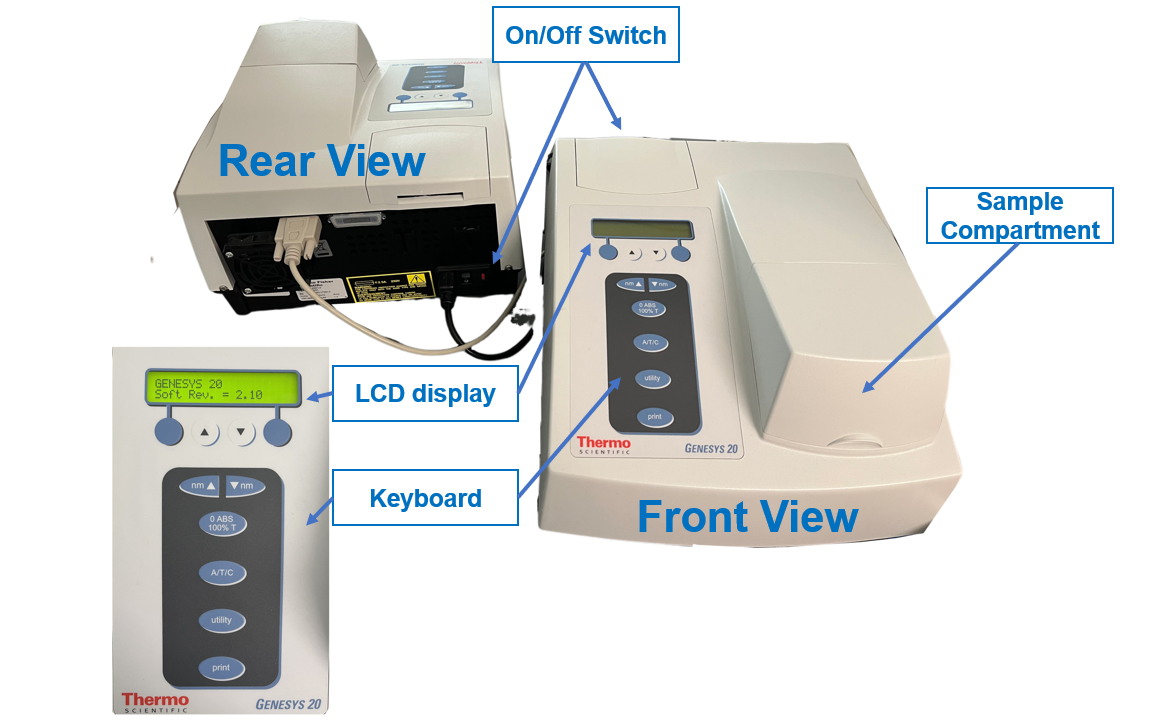2.7: Operating Instructions for Spec 20's
- Page ID
- 401635
\( \newcommand{\vecs}[1]{\overset { \scriptstyle \rightharpoonup} {\mathbf{#1}} } \) \( \newcommand{\vecd}[1]{\overset{-\!-\!\rightharpoonup}{\vphantom{a}\smash {#1}}} \)\(\newcommand{\id}{\mathrm{id}}\) \( \newcommand{\Span}{\mathrm{span}}\) \( \newcommand{\kernel}{\mathrm{null}\,}\) \( \newcommand{\range}{\mathrm{range}\,}\) \( \newcommand{\RealPart}{\mathrm{Re}}\) \( \newcommand{\ImaginaryPart}{\mathrm{Im}}\) \( \newcommand{\Argument}{\mathrm{Arg}}\) \( \newcommand{\norm}[1]{\| #1 \|}\) \( \newcommand{\inner}[2]{\langle #1, #2 \rangle}\) \( \newcommand{\Span}{\mathrm{span}}\) \(\newcommand{\id}{\mathrm{id}}\) \( \newcommand{\Span}{\mathrm{span}}\) \( \newcommand{\kernel}{\mathrm{null}\,}\) \( \newcommand{\range}{\mathrm{range}\,}\) \( \newcommand{\RealPart}{\mathrm{Re}}\) \( \newcommand{\ImaginaryPart}{\mathrm{Im}}\) \( \newcommand{\Argument}{\mathrm{Arg}}\) \( \newcommand{\norm}[1]{\| #1 \|}\) \( \newcommand{\inner}[2]{\langle #1, #2 \rangle}\) \( \newcommand{\Span}{\mathrm{span}}\)\(\newcommand{\AA}{\unicode[.8,0]{x212B}}\)
GENESYS 20 spectrophotometer
The Genesys 20 spectrophotometers are able to read single wavelength absorption of visible light. The instruments may look like the model shown in Figure \(\PageIndex{1}\) or may be grey in color.

Basic Operating Procedure
- Turn on the instrument with the ON-OFF power switch, located at the back of the instrument (see Figure \(\PageIndex{1}\)). Warm up the instrument for at least 20 minutes.
- Set the wavelength using the "nm arrow" buttons on the main keyboard (see Figure \(\PageIndex{1}\)). Do not use the arrows that are just below the LCD display; those are to toggle the LCD screen display.
- Set the instrument to read absorbance (A) using the A/T/C button on the keyboard. T is for transmittance.
- To “zero” the instrument on a blank sample, take a clean cuvette and fill the cuvette 3/4 with blank solution. Wipe the outside of the cuvette with a Kimwipe®. Place the cuvette in the cuvette holder inside the sample compartment so that the light path (front to back) is passing through the sample. Close the sample compartment cover. Zero the instrument with the "0 ABS, 100% T" button.
- The LCD screen should display the correct wavelength and 0.000 A. If it is not, check with your TA.
- Using the instrument is as simple as placing the sample to be measured into the cuvette holder, closing the sample compartment cover, waiting about 10 seconds for the reading to stabilize and recording the absorbance off the display.
- It is a good idea to check, from time to time, to make sure the instrument has not drifted. Do this by checking that a “blank” cuvette (one containing only blank solution) still has an absorbance of 0.000. If not, then the absorbance of samples cannot be trusted. If a blank does not read 0.000 then re-zero the instrument and repeat the previous samples. If the absorbance readings are drifting more than the expected uncertainty of the instrument, notify your TA.
- When you are finished using the instrument, remove the final sample from the sample compartment and turn off the instrument
NOTE: The manufacturer states that the uncertainty in the measured absorbance is ±0.003 absorbance units for absorbance readings from 0.001 to 0.300, and ±1% for absorbance reading from 0.301 to 2.50.
Video Instructions for operating a Genesys 20 Spec.
The video below is an excellent demonstration for how to use the Genesee 20 Spectrophotometer.


